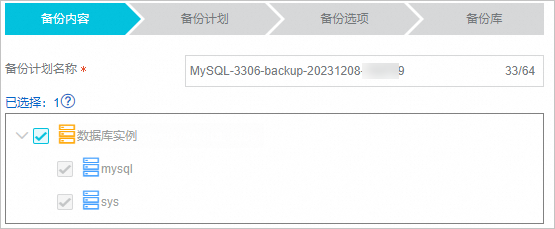為避免災難、硬體故障、資料丟失、損壞和意外刪除事故發生,建議您通過Cloud Backup及時對MySQL資料庫進行備份。Cloud Backup支援備份Elastic Compute Service執行個體或本機伺服器中部署的MySQL資料庫,將資料備份至雲端。您可以隨時根據時間點恢複資料庫至原資料庫,也可以恢複至同地區的其他ECS資料庫或本機資料庫。本文介紹如何備份MySQL資料庫。
前提條件
已開通阿里雲Cloud Backup服務。開通Cloud Backup不收取任何費用,使用Cloud Backup的Database Backup功能將產生如下費用:
Database Backup倉庫租用費。每UID前30天免費,贈送免費容量100GB/個/月。
Database Backup儲存容量費。按照重刪壓縮後容量收取,前30天免費,之後階梯定價。
價格詳情請參考價格詳情。
已在Cloud Backup控制台註冊MySQL資料庫。
Cloud Backup支援协助发现已安裝雲助手的Elastic Compute Service執行個體中的MySQL資料庫。您需要準備好資料庫使用者名稱和密碼。具體操作,請參見註冊MySQL(ECS)。
對於使用者自建的本機伺服器MySQL資料庫。您需要在本機伺服器安裝備份用戶端。具體操作,請參見註冊MySQL(本地)。
如果為Elastic Compute Service中的MySQL資料庫,建議通過預檢功能提前發現不適合備份的情境,包括管控網路連接性檢查、OSS串連性檢查、支援全量備份版本檢查和BINLOG檢查。具體操作,請參見預檢MySQL(ECS)。
注意事項
本機資料庫伺服器的網路必須通過專線或者VPN和阿里雲Virtual Private Cloud及路由(線下到雲上100.64.0.0/10、100.64.0.0/11或100.96.0.0/11)互連。具體操作,請參見建立VPC到本機資料中心的串連(單隧道模式)。
啟用資料庫防勒索功能後,將無法使用MySQL的備份功能。防勒索的更多資訊,請參見什麼是防勒索。
MySQL備份功能不支援對容器裡的資料庫進行備份。
支援的資料庫版本、作業系統和備份功能有限制,例如不支援部署在Windows中的MySQL資料庫。更多資訊,請參見相容系統列表和使用限制。
建立備份計劃時,請合理選擇備份庫,避免把一個資料庫的資料備份到不同的備份庫。例如,同一個資料庫執行個體建議備份到一個備份庫中,否則可能會導致增量/記錄備份轉換為全量備份從而額外佔用備份庫儲存空間。
如果同時使用其他備份軟體或指令碼進行全量備份、增量備份或記錄備份時,雲備份進行增量備份或記錄備份時不會受影響。需要您注意,在使用一些第三方的軟體進行全量備份時會對MySQL進行加鎖,導致雲備份任務發生阻塞,從而順延強制,在控制台上執行全量備份時會出現延遲現象。
MySQL備份功能不支援對單機(本機伺服器和ECS)上的多個 MySQL 執行個體進行備份。
建立備份MySQL計劃
備份計劃建立完成後,備份計劃的狀態為计划中,Cloud Backup將按照指定的備份起始時間、備份執行間隔進行MySQL備份任務。具體操作如下:
單擊,選擇所在地區,然後單擊MySQL。單擊ECS数据库实例或者本地数据库实例頁簽。找到目標MySQL執行個體,在其右側的操作列表,單擊备份。

在建立備份計劃面板,配置如下資訊。
配置備份內容,然後單擊下一步。
輸入备份计划名称。
選中您需要備份的資料庫執行個體。

配置備份計劃,然後單擊下一步。
參數
說明
推薦策略
推薦的備份策略。Cloud Backup提供如下預製備份策略,您可以根據具體需求選擇,也可以自訂備份策略。
典型策略:即開啟全量備份和增量備份功能。
關鍵應用:即開啟全量備份、增量備份和記錄備份功能。
自訂:即自訂備份類型,自行選擇增量或即時備份,設定開始時刻、備份間隔等。
全量備份
全量備份資料庫檔案,備份內容是作業系統上所有資料庫檔案。恢複時只能恢複到具體備份的時間點。
您可以選擇立即或按指定時間備份一次,也可以選擇按小時、按天、按星期或按月進行周期備份。
增量備份
只備份增量部分資料庫檔案,備份內容是作業系統上增量資料庫檔案。恢複時只能恢複到具體備份的時間點。
您可以選擇立即或按指定時間備份一次,也可以選擇按小時、按天、按星期或按月進行周期備份。
重要使用MyISAM引擎(MySQL 5.5之前的版本)的MySQL資料庫不支援增量備份,雲備份預設將增量備份轉為全量備份。
增量備份資料在恢複時依賴最近的一個全量備份,因此在增量備份資料到期前,其對應的全量備份也不會被回收。請合理配置備份周期和到期時間。更多資訊,請參見Database Backup庫清除到期備份的機制是怎樣的?。
記錄備份
資料庫記錄備份,支援按照固定周期進行備份。
您可以選擇立即或按指定時間備份一次,也可以選擇按小時、按天、按星期或按月進行周期備份。
重要記錄備份資料在恢複時依賴最近的一個全量備份,因此在記錄備份資料到期前,其對應的全量備份也不會被回收。請合理配置備份周期和到期時間。更多資訊,請參見Database Backup庫清除到期備份的機制是怎樣的?。
如果備份的節點是從庫(slave 節點),為了確保記錄備份的正常進行,需要在設定檔中設定配置項
log_slave_updates=1,即開啟此配置項。完成此配置更改後,建議先執行一次全量備份,然後再進行記錄備份。
即時備份
即時備份資料庫的日誌資料。
開啟即時備份前,需要完成一次全量備份。開啟即時備份後,正常情況下會持續備份資料庫的日誌資料,因此,恢複資料時可達到秒級RPO。免費期內,可以免費使用即時備份;免費期過後,雲備份立即按照即時備份佔用的儲存量收費。費用詳情請參見價格詳情。
重要單個MySQL資料庫執行個體僅允許建立一個包含即時備份的計劃。
配置備份選項,然後單擊下一步。
參數
說明
並發數
備份資料時的並發線程數量。
斷線重連時間
備份時,斷開資料庫後重新串連的時間間隔。單位為分鐘。
限速
每秒備份的資料大小。單位為MB/s。
說明取值為0代表不限制備份速度。
配置備份庫,然後單擊確定。
重要目前一個執行個體只能備份到同一個備份庫,不支援備份到多個備份庫。
參數
說明
备份库配置
配置備份儲存的備份庫。
建立備份庫:建立備份庫的名稱命名。可不填,預設名字隨機分配。
選擇備份庫:從備份庫名稱下拉框中選擇已有備份庫。
重要備份庫建立成功之後,無論是否有備份資料產生,都會收取Database Backup倉庫租用費。 更多資訊,請參見計費方式與計費項目。
為了最大程度地保障您備份資料的冗餘性,在支援同城冗餘備份庫的地區,Cloud Backup將預設使用相應的同城冗餘備份庫;如果備份庫所在地區只能提供本地冗餘備份庫,Cloud Backup將使用本地冗餘備份庫。您無需對備份庫類型進行手動選擇。
备份库名称
指定備份庫的名稱。
備份保留時間
備份保留時間。時間單位:天、周、月、年。
您可以在存放庫管理頁面更改備份保留時間。該更改對備份庫新產生的所有備份資料生效。保留時間到期後,會自動刪除。
重要增量備份、記錄備份資料在恢複時依賴最近的一個全量備份,因此在增量備份、記錄備份資料到期前,其對應的全量備份也不會被回收。請合理配置備份周期和到期時間。更多資訊,請參見Database Backup庫清除到期備份的機制是怎樣的?。
備份計劃建立完成。
備份成功
全量備份是增量備份的前提,請優先手動執行一次。
備份計劃建立完成後,您可以在备份计划頁簽,看到詳細的備份計劃。包括全量備份、增量備份、記錄備份的下次執行時間、備份間隔等。Cloud Backup將按照指定的備份起始時間、備份執行間隔等進行MySQLDatabase Backup任務。
當達到備份執行時間時,Cloud Backup就會啟動執行備份計劃。當備份任務状态為空闲且顯示下次执行時間時,表示當次備份完成。

常見問題
更多操作
在備份計劃頁簽,找到目標備份計劃,在其右側的操作欄,您還可以執行如下操作。
編輯備份計劃
已建立的備份計劃無法滿足實際需求,您可以通過單擊編輯,修改備份計劃。
警示設定
您可以通過單擊操作欄下的,然後選擇備份警示方式。
備份警示方式
說明
關閉
該用戶端不再發送警示通知。
跟備份庫警示一致
該用戶端使用與備份庫一致的警示方式。
預設通知
該用戶端的備份警示通知會以郵件的形式發送給阿里雲帳號。
自訂
需選擇一個或多個連絡人(組)。完成配置後,該用戶端會發送備份警示給已選擇的連絡人(組)。
刪除備份計劃
刪除備份計劃會導致正在執行的備份、恢複任務中斷。
您可以通過單擊操作列下的,刪除不再需要的備份計劃。
後續步驟
相關文檔
如果您想瞭解備份Database Backup的優勢、工作原理、操作流程、使用限制等,請參見功能概覽(ECS資料庫)和功能概覽(本機資料庫)。
Cloud Backup支援跨帳號備份。